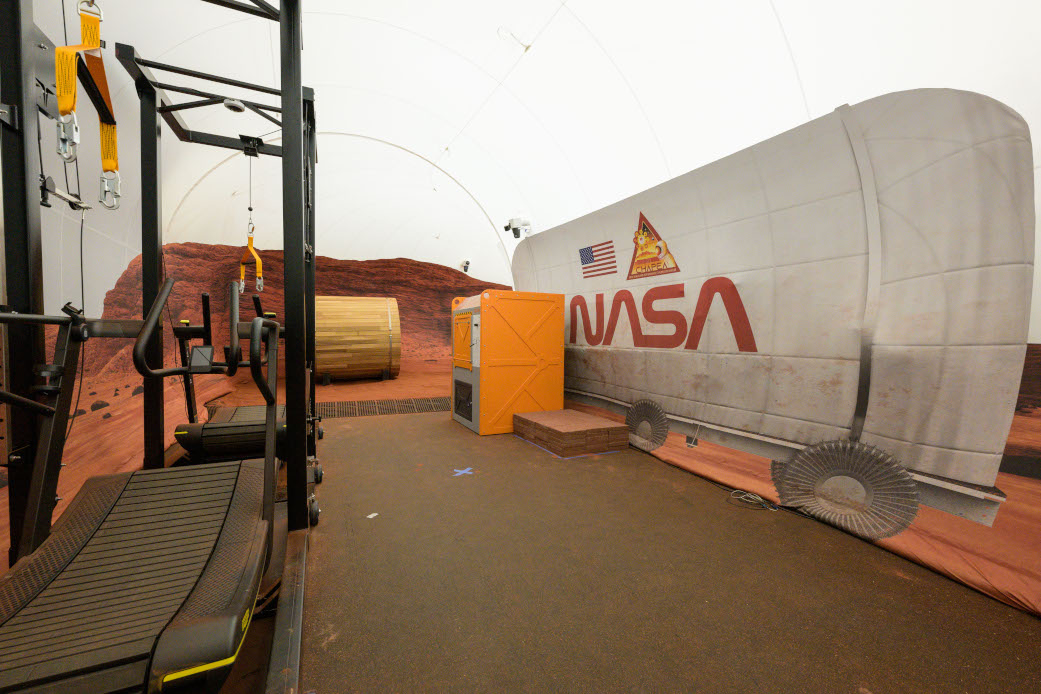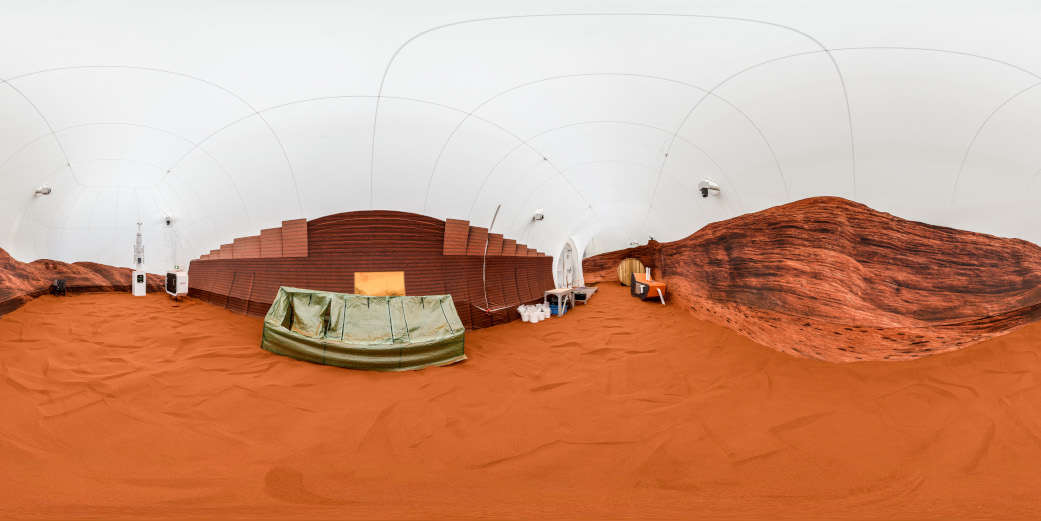Settling on Mars in the future means withstanding radiation levels, lack of oxygen, frozen water buried under polar ice caps, and cold weather plunging as far as -220 degrees Fahrenheit, to name a few challenges. Since new off-Earth environments mean entirely different living possibilities, NASA wants to study how astronaut-like individuals will adapt to the rigors of life on Mars before humans get there (no sooner than 2033).
On November 2022, NASA and 3D printing construction giant ICON completed the construction of Mars Dune Alpha, a 3D-printed, 1,700-square-foot habitat at NASA’s Johnson Space Center in Houston, Texas, that will simulate the challenges of a mission to Mars. This mission is the first of three planned in NASA’s Crew Health and Performance Analog, or CHAPEA, mission. Now, the agency has announced that the first mission is scheduled to begin in June, when the volunteer crew, who are not astronauts but had to pass standard NASA criteria for astronauts, enter the 3D-printed habitat.
3D printed by ICON and designed by Bjarke Ingels Group (BIG), the Martian simulated habitat will resemble the expected experience for those living on the red planet in the future and will aid in long-duration science missions. It was built using ICON’s next-generation Vulcan construction system and proprietary lavacrete material.
Fitted with private crew quarters, a kitchen, and dedicated areas for medical, recreation, fitness, work, and crop growth activities, as well as a technical work area and two bathrooms, the 3D printed habitat could resemble what the first Martian living quarters might look like in the next decade.

The sandbox portion of the Crew Health and Performance Exploration Analog habitat contains equipment such as a treadmill for use during virtual reality traverses. Image courtesy of NASA/Bill Stafford
During the year-long simulation, crew members will carry out different mission activities, including simulated spacewalks or “Marswalks” outside the habitat (some using virtual reality technology), robotic operations, habitat maintenance, personal hygiene, exercise, and crop growth. To be as Mars-realistic as feasible, the crew will also face environmental stressors such as resource limitations, isolation, and equipment failure.
CHAPEA Deputy Project Manager at Johnson, Raina MacLeod, said the agency would look at how the crew performance and health change based on realistic Mars restrictions and lifestyle.
“The lifestyle is what we’re trying to simulate by setting up a realistic environment and workload for the CHAPEA crew,” stressed MacLeod.
Since Mars has about a third of Earth’s gravity, it will present unique challenges for eventual human missions. To that end, the agency has created a 1,200-square-foot “sandbox” portion filled with red sand to simulate the Martian landscape and contains equipment such as a treadmill for the virtual reality walks.

A 360-degree view inside the sandbox portion of the Crew Health and Performance Exploration Analog habitat at NASA’s Johnson Space Center in Houston. Image courtesy of NASA/Bill Stafford
The objective of each traverse will vary throughout the mission. For example, during some of the simulated spacewalks, the crew will focus on field geology work by locating and identifying rocks of interest, communicating unique characteristics to the crew inside the habitat to enter into a database, taking photographs for documentation, and retrieving a sample from the rock and bringing it into the habitat for analysis. During others, the crew will evaluate sites for simulated construction activities.
Some virtual reality traverses include simulated science and maintenance activities, such as setting up experiment packages or performing dust mitigation steps to optimize solar panel functionality.

The first one-year analog mission in a habitat to simulate life on a distant world begins summer of 2023. Image courtesy of NASA.
“We thought through a few different types of spacewalks that would be realistic to what astronauts would do on the surface of Mars,” explains MacLeod. “We would have them do geology work, and then they probably would do some building tasks, and then also exploration. So, those are the three categories we are looking at for CHAPEA – geology, building, and exploration.”
In addition to the simulated traverses, crew members will spend time remotely operating robotic elements, which will likely be necessary for actual crews on Mars to extend their exploration capabilities.

Inside the Crew Health and Performance Exploration Analog habitat there is a geology workstation complete with a glovebox to analyze rock samples collected during simulated spacewalks. Image courtesy of NASA/Bill Stafford
During the CHAPEA robotic operations, crew members will be responsible for controlling a helicopter-like drone and a roving robot. The crew will work in pairs inside the habitat to operate the drone and robot to survey remote areas, identify and retrieve rock samples, and document geological information.
“The robotics element is a very interesting activity that we are including for our crew. It’s always good to have really stimulating tasks, especially on a long-duration analog study, to keep the crew excited,” MacLeod went on. “But these activities could also be very realistic in that future Mars astronauts could utilize remote piloting drones and rovers to expand the reconnaissance radius.”
NASA is leading a return to the Moon for long-term science and exploration through Artemis missions. Lessons learned from the first crew to emerge from NASA’s ground-based, simulated Mars habitat will help the agency better prepare for the challenges crews might encounter there. This is one of the most critical steps for the agency’s Moon to Mars exploration approach.
Subscribe to Our Email Newsletter
Stay up-to-date on all the latest news from the 3D printing industry and receive information and offers from third party vendors.
You May Also Like
Gorilla Sports GE’s First 3D Printed Titanium Cast
How do you help a gorilla with a broken arm? Sounds like the start of a bad joke a zookeeper might tell, but it’s an actual dilemma recently faced by...
Nylon 3D Printed Parts Made More Functional with Coatings & Colors
Parts 3D printed from polyamide (PA, Nylon) 12 using powder bed fusion (PBF) are a mainstay in the additive manufacturing (AM) industry. While post-finishing processes have improved the porosity of...
$25M to Back Sintavia’s Largest Expansion of Metal 3D Printing Capacity Since 2019
Sintavia, the digital manufacturing company specializing in mission-critical parts for strategic sectors, announced a $25 million investment to increase its production capacity, the largest expansion to its operations since 2019....
Velo3D Initiates Public Offering in a Bid to Strengthen Financial Foundations and Drive Future Growth
Velo3D (NYSE: VLD) has been among a number of publicly traded 3D printing firms that have attempted to weather the current macroeconomic climate. After posting a challenging financial report for 2023,...































